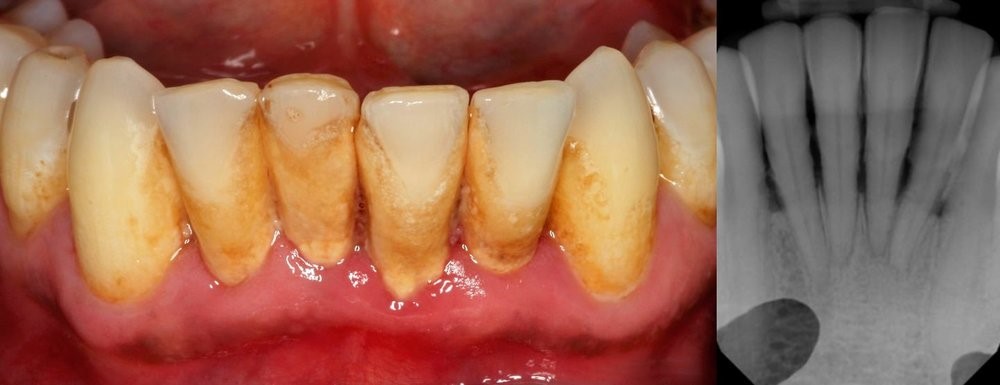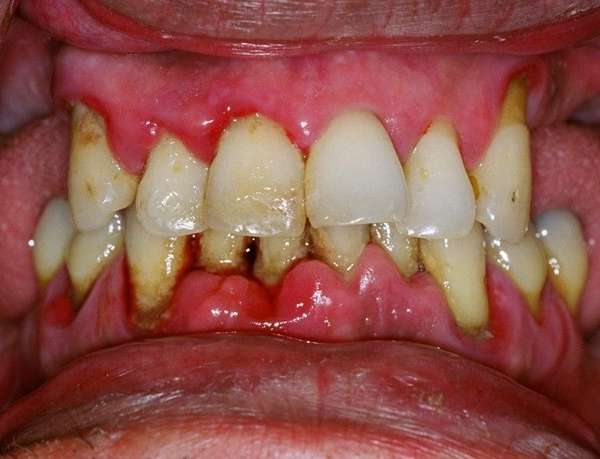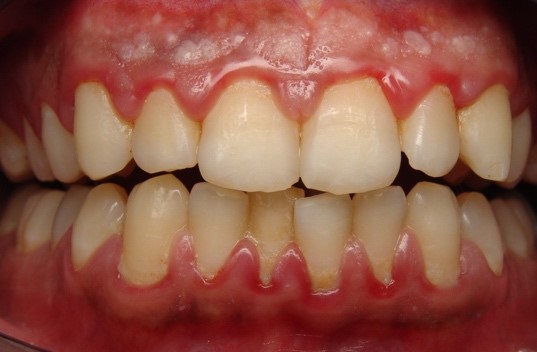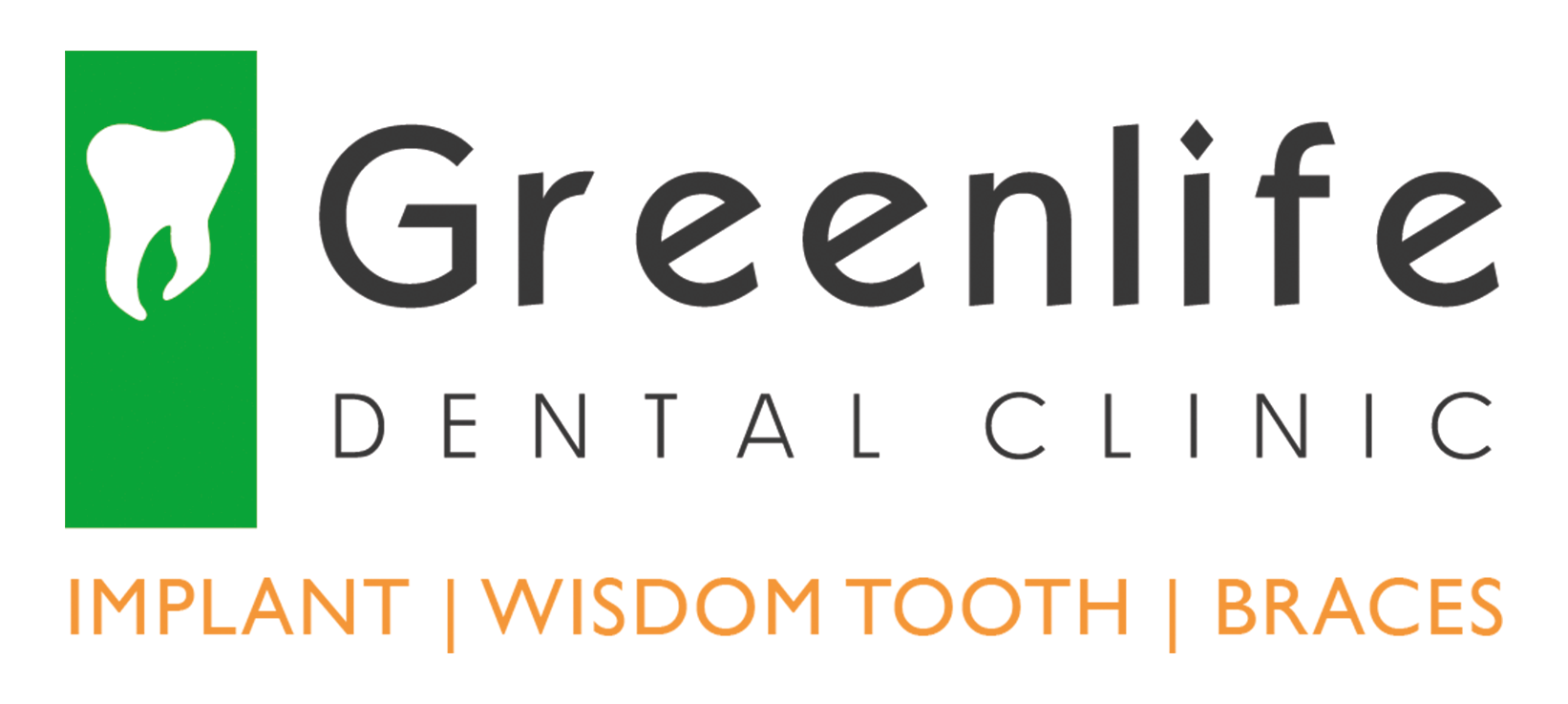
What is Periodontal (Gum) Treatment?


This procedure involved a 2 cleaning steps.
First step is deep scaling, using a machine scaler with a vibrating metal tip that chip away the hardened plaque or tartar.
After this round of cleaning, the second step is root-planning where the roots of the affected teeth are clean using hand instruments called hand scaler or curette.
The dentist will scrap the rough root surfaces manually to remove and smoothen the infected root surfaces.
He will also rely on his sense of touch to identify and clean out to difficult to reach areas of tartar build-up and rough spots left behind by the machine scaler.
Severe gum disease called periodontitis, is an advanced stage of gum disease that destroy the bone that support the teeth.
The destruction of bone and gum caused by periodontitis is irreversible, these hard and soft tissue destroyed will not grow back again. There is no cure for severe gum disease but we can stop the continual destruction by removing the source of infection that lie deep below the gum lime on the root surface of the affected teeth, which are the plaque and tartar.
Your aim is to keep and protect your remaining bone and gum that are supporting your teeth with proper oral hygiene maintenance for the rest of your life, or else the gum disease will return to destroy the support and eventually, the affected teeth will be lost.


If this is not treated early and allowed to progress to periodontitis, as more plaque and tartar invade deeper and deeper into the root surfaces, the bacteria will start to destroy the bone support of the teeth.
Why Should You Do Periodontal (Gum) Treatment?
Once the gum disease has progress from a mild form (gingivitis) to a more severe form (periodontitis), the accumulation of plaque (germs) and tartar on the deep parts of the root surfaces create a space between the teeth and gum, called a “pocket”.
These gum pockets serve as reservoirs for more infection and destruction to take place as bristles of our brush cannot reach deep into these pockets during brushing.
Only professional gum treatment done by a dentist can help you remove the plaque and tartar for you. Diabetic patients have a higher risk of developing severe gum disease because of their weakened immune system.
There are several serious medical conditions associated with severe gum disease like diabetes, stroke, heart disease, impotency for men and miscarriage, premature delivery and low-birth weight for women.
Visit our dentist if you have any of these signs of gum disease like bleeding gum, bad breath, painful teeth on biting, drifting and shaky teeth.
The first step to improve your condition is to visit our dentist and get the condition diagnosed and appropriate treatment can be done to save, not only your teeth but maybe your life.
FAQs
Is periodontal (gum) treatment painful?
Generally, gum treatment is not expected to cause much discomfort if it is not too severe and the gum pockets are not too deep because it is a non-invasive procedure. However, the level of pain you will feel depend on your tolerance and the severity of your tartar build-up. You may feel the vibration, movement, or pressure as the scaling instruments probe around your teeth and remove plaque. On the other hand, if you have deeper pockets and more build-up, you may experience more discomfort, sensitivity and pain.
Most of the time, we do recommend local anaesthesia to numb the gum so that the dentist can clean deep inside the gum pockets without you feeling any pain or discomfort. This will make the long duration of the gum treatment much more pleasant and relaxing for you and also more efficient for our dentist to do a more thorough job.
How long does periodontal (gum) treatment take?
In most cases, one side of the mouth (either upper or lower teeth) is cleaned at the clinic. The average time per visit is 45-60 minutes. In some cases, depending on the severity of the gum condition, our dentist may do only one quadrant each over 4 visits.
How often should you do periodontal (gum) treatment?
Deep cleaning should be performed at least once for those with severe gum disease. Our dentist will assess how well the gum respond after the first round of gum treatment. The most important part of the gum treatment is patient education and self-maintenance program at home. If the gum responds well with a highly motivated patient with good home care, then the patient can come only for regular scaling every 3-4 months. If the gum does not respond well, a repeated deep cleaning session may be recommended. Sometime, we may refer you to a gum specialist or periodontist to reassess and treat those cases that are more difficult to treat.
What is the difference between scaling and gum treatment?
Gum treatment is not the same as regular superficial teeth cleaning (scaling). Normal scaling involves the removal of plaque and tartar that are lying above the gum line. There are no gum pockets in mild gum disease (gingivitis) as the bone has not been destroyed yet.
Once gum pockets start to form, destruction of the underlying bone has begun. Gum treatment is a thorough way of cleaning the teeth and root surfaces deep in the gum pockets in order to get rid of bacteria and tartar that are trapped deep below the gum level. This is the key difference between normal scaling and deep cleaning of the gum.
Why is gum/periodontal (deep scaling) treatment more expensive than regular scaling?
This is due to the increased time and effort spend by the dentist to solve the gum disease compared to regular scaling. Local anaesthesia is frequently used to make the procedure more comfortable. Post treatment medications like pain-killers, mouth rinse and antibiotics are also given to control the pain and infection.
Can I choose not to do gum treatment?
It is entirely up to you to decide whether you want to receive the treatment that our dentist recommends. Normal scaling will not treat severe gum disease because the removal of plaque and tartar that lie above the gum line will not treat the disease as most of the active infection is occur deep inside the gum pockets. However, if you do not resolve your gum problems, you may end up losing all your teeth in the future. This will be even more costly in terms of functional, physical, mental and financial loss when it happens. Many of our patients who lose their teeth regrets that they did not have the courage or awareness to seek treatment early, so do not become one of them.
Why do my gums still bleed after gum treatment?
General soreness, sensitive teeth and bleeding gums are normal after deep cleaning. Usually it takes about 2-3days for the gum to recover after deep cleaning. Meanwhile, the healing gum may still bleed a bit but will definitely stop after a few days. The cleaned teeth may become more sensitive to hot and cold drink/food as the roots that were covered with tartar is now cleaned and directly come into contact with temperature changes. The teeth will take a few days or weeks to adapt to these changes. If the sensitivity is severe, specific toothpaste formulated for sensitive teeth may be recommended to you.
Can I eat normally after gum treatment?
Yes, you can eat after the anaesthesia or numbness wear off so that you can taste and feet your food. It also prevents you from biting or burning yourself while the mouth is still numb. Be gentle when eating or drink hot/cold as the newly cleaned teeth are sensitive to extreme temperature stimulation.

